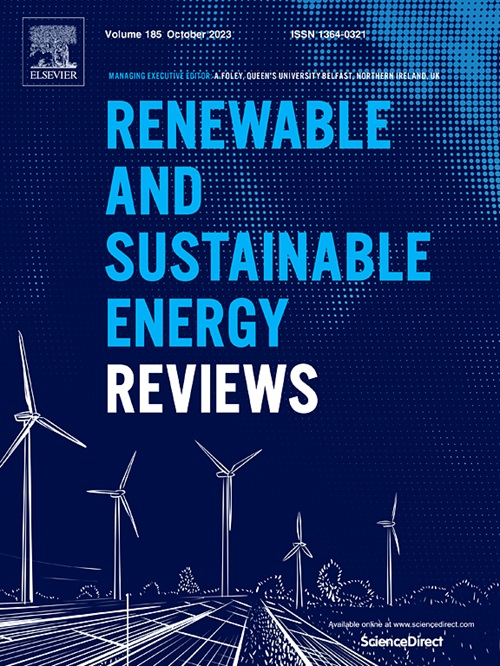电制气应用中碱性、固体氧化物和阴离子交换膜电解槽的热经济性比较
IF 16.3
1区 工程技术
Q1 ENERGY & FUELS
引用次数: 0
摘要
本研究对动态条件下运行的三种电制气(PtG)系统进行了比较热经济分析,每个系统都集成了不同的电解技术:固体氧化物电解池(SOEC),碱性电解池(AEC)和阴离子交换膜(AEM)电解。每个系统通过电解将光伏(PV)场产生的多余电力转化为氢气。然后,氢气与从热电联产(CHP)装置的废气中捕获的二氧化碳在一个三级催化甲烷化反应器中结合,产生合成甲烷。该系统为多用途设施提供能源。甲烷化反应器模拟为以Ni/Al2O3为催化剂,液态水冷却的三级固定床催化反应器。电解槽和甲烷化器模型都纳入了依赖温度的反应动力学,并模拟了现实的瞬态行为。采用TRNSYS软件进行了动态仿真,并用MatLab对高级部件进行了建模。能源结果表明,基于soec的系统在综合转换效率(0.56 vs. 0.48和0.49)、一次节能(46.90% vs. 43.90%和43.96%)和二氧化碳减排(74.16% vs. 71.77%和71.84%)方面均优于AEC和aem系统。为了进一步评估系统的可扩展性和投资可行性,对SOEC配置进行了多目标优化。优化确定了两种帕累托最优配置:第一种是实现56%的一次能源节约(PES),简单的投资回收期(SPB)为5.41年;第二种是实现57%的一次能源节约(PES), SPB略长,为5.52年。在这两种情况下,多余电量的削减都保持在8%以下,电化学链成本保持在总投资的45%以下。结果证实,最佳的系统规模,特别是电解槽和甲烷化装置,对于实现成本效益和节能的PtG部署至关重要。本文章由计算机程序翻译,如有差异,请以英文原文为准。
Thermoeconomic Comparison of Alkaline, Solid Oxide and Anion Exchange Membrane Electrolyzers for Power-to-Gas Applications
This study presents a comparative thermoeconomic analysis of three Power-to-Gas (PtG) systems operating under dynamic conditions, each integrating a different electrolysis technology: solid oxide electrolysis cell (SOEC), alkaline electrolysis cell (AEC), and anion exchange membrane (AEM) electrolysis. Each system converts excess electricity from a photovoltaic (PV) field into hydrogen via electrolysis. The hydrogen is then combined with carbon dioxide – captured from the exhaust gases of a combined heat and power (CHP) unit – within a three-stage catalytic methanation reactor to produce synthetic methane. This system supplies energy to mixed-use facilities. The methanation reactor is modelled as a three-stage fixed-bed catalytic reactor using Ni/Al2O3 as the catalyst, cooled by liquid water. Both the electrolyzer and methanator models incorporate temperature-dependent reaction kinetics and simulate realistic transient behaviour. Dynamic simulations were carried out using TRNSYS, while advanced components are modelled in MatLab. Energy results show that the SOEC-based system outperforms the AEC and AEM-based systems in terms of overall conversion efficiency (0.56 vs. 0.48 and 0.49), primary energy savings (46.90% vs. 43.90% and 43.96%), and CO2 emissions avoided (74.16% vs. 71.77% and 71.84%). To further assess system scalability and investment viability, a multi-objective optimization was carried out on the SOEC configuration. The optimization identified two Pareto-optimal configurations: the first achieves 56% primary energy savings (PES) with a simple payback period (SPB) of 5.41 years, while the second reaches 57% PES with a slightly longer SPB of 5.52 years. In both cases, curtailment of excess electricity was kept below 8%, and electrochemical chain costs remained under 45% of total investment. The results confirm that optimal system sizing – particularly of the electrolyzer and methanation units – is crucial to achieve a cost-effective and energy-efficient PtG deployment.
求助全文
通过发布文献求助,成功后即可免费获取论文全文。
去求助
来源期刊

Renewable and Sustainable Energy Reviews
工程技术-能源与燃料
CiteScore
31.20
自引率
5.70%
发文量
1055
审稿时长
62 days
期刊介绍:
The mission of Renewable and Sustainable Energy Reviews is to disseminate the most compelling and pertinent critical insights in renewable and sustainable energy, fostering collaboration among the research community, private sector, and policy and decision makers. The journal aims to exchange challenges, solutions, innovative concepts, and technologies, contributing to sustainable development, the transition to a low-carbon future, and the attainment of emissions targets outlined by the United Nations Framework Convention on Climate Change.
Renewable and Sustainable Energy Reviews publishes a diverse range of content, including review papers, original research, case studies, and analyses of new technologies, all featuring a substantial review component such as critique, comparison, or analysis. Introducing a distinctive paper type, Expert Insights, the journal presents commissioned mini-reviews authored by field leaders, addressing topics of significant interest. Case studies undergo consideration only if they showcase the work's applicability to other regions or contribute valuable insights to the broader field of renewable and sustainable energy. Notably, a bibliographic or literature review lacking critical analysis is deemed unsuitable for publication.
 求助内容:
求助内容: 应助结果提醒方式:
应助结果提醒方式:


